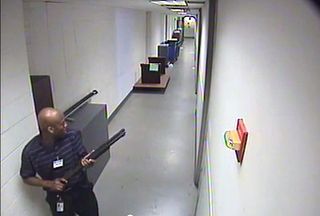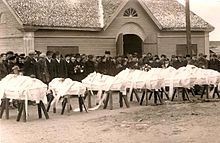
A school shooting is an armed attack at an educational institution, such as a primary school, secondary school, high school or university, involving the use of a firearm. Many school shootings are also categorized as mass shootings due to multiple casualties. The phenomenon is most widespread in the United States, which has the highest number of school-related shootings, although school shootings have taken place elsewhere in the world.

Homicide is an act in which a human causes the death of another human.
A spree killer is someone who commits a criminal act that involves two or more murders in a short time, often in multiple locations. There are different opinions about what durations of time a killing spree may take place in. The United States Bureau of Justice Statistics has spoken of "almost no time break between murders", but some academics consider that a killing spree may last weeks or months, e.g. the case of Andrew Cunanan, who murdered five people over three months.
A lone wolf attack, or lone actor attack, is a particular kind of mass murder, committed in a public setting by an individual who plans and commits the act on their own. In the United States, such attacks are usually committed with firearms. In other countries, knives are sometimes used to commit mass stabbings. Although definitions vary, most databases require a minimum of four victims for the event to be considered a mass murder.
A murder–suicide is an act where an individual intentionally kills one or more people before or while killing themselves. The combination of murder and suicide can take various forms:

Active shooter is a term used to describe the perpetrator of an ongoing mass shooting. The term is primarily used to characterize shooters who are targeting victims indiscriminately and at a large scale, who oftentimes, will either commit suicide or intend to be killed by police. More generally, an active perpetrator of a mass murder may be referred to as an active killer.

Gun-related violence is violence committed with the use of a firearm. Gun-related violence may or may not be considered criminal. Criminal violence includes homicide, assault with a deadly weapon, and suicide, or attempted suicide, depending on jurisdiction. Non-criminal violence includes accidental or unintentional injury and death. Also generally included in gun violence statistics are military or para-military activities.
A copycat crime is a criminal act that is modeled after or inspired by a previous crime. It notably occurs after exposure to media content depicting said crimes, and/or a live criminal model.
Crime in California refers to crime occurring within the U.S. state of California.

A mass shooting is a violent crime in which one or more attackers kill or injure multiple individuals simultaneously using a firearm. There is no widely accepted definition of "mass shooting" and different organizations tracking such incidents use different definitions. Definitions of mass shootings exclude warfare and sometimes exclude instances of gang violence, armed robberies, familicides and terrorism. The perpetrator of an ongoing mass shooting may be referred to as an active shooter.
Crime in Oakland, California began to rise during the late 1960s after the King assassination riots, and by the end of the 1970s Oakland's per capita murder rate had risen to twice that of San Francisco or New York City. In 1983, the National Journal referred to Oakland as the "1983 crime capital" of the San Francisco Bay Area. Crime continued to escalate during the 1980s and 1990s, and during the first decade of the 21st century Oakland has consistently been listed as one of the most dangerous large cities in the United States.

Mass shootings are incidents involving multiple victims of firearm related violence. Definitions vary, with no single, broadly accepted definition. One definition is an act of public firearm violence—excluding gang killings, domestic violence, or terrorist acts sponsored by an organization—in which a shooter kills at least four victims. Using this definition, a 2016 study found that nearly one-third of the world's public mass shootings between 1966 and 2012 occurred in the United States, In 2017 The New York Times recorded the same total of mass shootings for that span of years. A 2023 report published in JAMA covering 2014 to 2022, found there had been 4,011 mass shootings in the US, most frequent around the southeastern U.S. and Illinois. This was true for mass shootings that were crime-violence, social-violence, and domestic violence-related. The highest rate was found in the District of Columbia, followed by Louisiana and Illinois.

The Kerch Polytechnic College massacre was a school shooting and bomb attack that occurred in Kerch, Crimea, on 17 October 2018, when 18-year-old student Vladislav Roslyakov killed 20 people and wounded 70 others before subsequently committing suicide. It was the deadliest school shooting in the former Soviet Union since the 2004 Beslan school siege.

Mass shooting contagion theory is the studied nature and effect of media coverage of mass shootings and the potential increase of mimicked events. Academic study of this theory has grown in recent years due to the nature of mass shooting events, frequency of references to previous rampage shooters as inspiration and the acquisition of fame using violence, particularly in the United States. The Columbine High School massacre is cited as being the first shooting to receive nationwide 24/7 publicity, giving both shooters near instant widespread infamy, and thus often is claimed by researchers as being a source of inspiration for would be copycat mass shooters.
A mass stabbing is a single incident in which multiple victims are harmed or killed in a knife-enabled crime. In such attacks, sharp objects are thrust at the victim, piercing through the skin and harming the victim. Examples of sharp instruments used in mass stabbings may include kitchen knives, utility knives, sheath knives, scissors, katanas, hammers, screwdrivers, icepicks, bayonets, axes, machetes and glass bottles. Knife crime poses security threats to many countries around the world.

The Columbine effect is the legacy and impact of the Columbine High School massacre, which occurred on April 20, 1999 at Columbine High School in Columbine, Colorado. The shooting has had an effect on school safety, policing tactics, prevention methods, and inspired numerous copycat crimes, with many killers taking their inspiration from Eric Harris and Dylan Klebold by describing the two perpetrators as being martyrs or heroes.









